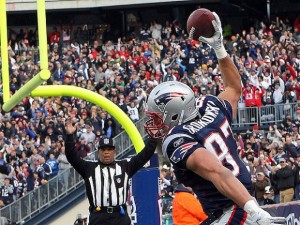The Cincinnati Bengals appear to be moving to a two-tight end offense in 2013, with first round pick Tyler Eifert joining former first rounder Jermaine Gresham. Since Rob Gronkowski and Aaron Hernandez began dominating the league, the two-tight end offense has become back in vogue in the NFL.
I say “back” because contrary to popular belief, the two-tight end offense didn’t begin with Bill Belichick’s Patriots. Only one team in NFL history has seen its top two leaders in receptions both play tight end, and it wasn’t a team coached by Belichick. That team was the 1998 Titans, with Les Steckel as offensive coordinator. Tennessee had bought high on Yancey Thigpen after the 1997 season, a move that backfired immediately; instead, 27-year-old Frank Wycheck and 30-year-old Jackie Harris led the team in receptions, and each started 16 games. Seven years later, this time under Norm Chow, Erron Kinney and Ben Troupe each caught 55 passes, just three behind leader Drew Bennett. The fourth leader in receptions was another tight end, Bo Scaife. The 2005 Titans really liked their tight ends.
Wes Welker led the 2011 Patriots in receptions and receiving yards, but Gronkowski and Hernandez were second and third in both categories. In addition to those Titans teams, here are some other franchises that had multiple tight ends finish in the top three in receptions:
- One edition of the Mike Shanahan/Gary Kubiak Broncos make the list. In 2001, Desmond Clark (51 catches) and Dwayne Carswell (34 catches as the blocking tight end) were the only other Broncos with more than 15 receptions. Of course, Rod Smith caught 113 balls that season.
- Jim Mora’s 1995 Saints ran a two-tight end offense behind the team’s top offensive weapon, Quinn Early. Wesley Walls, before he starred in Carolina, caught 57 passes for 694 yards that season, while Irv Smith started 16 games and caught 45 passes for 466 yards.
- John Robinson’s Rams appear twice on the list. In 1988, with Ernie Zampese as offensive coordinator (and Norv Turner as tight ends coach), Los Angeles went 10-6 and finished third in the league in points scored with Jim Everett at quarterback. The offensive star was Henry Ellard, but Pete Holohan (59-640-3) and Damone Johnson (42-350-6 in 16 starts) were the only other players with more than 30 receptions. In 1985, under “rookie” sensation Dieter Brock, Tony Hunter and David Hill finished behind Ellard in receptions, as the team ran a two-tight end offense in lieu of putting a fullback in front of Eric Dickerson.
- A couple hundred miles south, Zampese and Don Coryell had a 2-TE offense in 1984. That year, Charlie Joiner led the team with 61 receptions, but Pete Holohan (56 catches for 734 yards in 15 games) and Kellen Winslow (55 catches for 663 yards in just seven games) finished second and third in receptions. A third tight end, Eric Sievers, caught 41 passes in 13 starts. Winslow, Sievers, and Holohan started 28 games for San Diego in 1983, too.
- That wasn’t unusual for 1984. The Oilers were horrible that season, but tight ends Jamie Williams and Chris Dressel each started 16 games and caught 40 passes for the team, finishing second and third in catches. In New England, tight end Derrick Ramsey (66-792-7) led the team in all receiving categories, while TE Lin Dawson started 15 games and caught 39 passes.
The 1979 Raiders had an embarrassment of riches at the position, as Oakland sent Raymond Chester (58-712-8) and Dave Casper (57-771-3) to the Pro Bowl. The next season, Casper would be part of an Oilers team that traded for him in mid-season and started two tight ends and a fullback (with just one wide receiver) next to Earl Campbell. Casper caught 56 passes for 796 yards with the Raiders and Oilers that year, while Houston’s other tight end Mike Barber had 59 receptions for 712 yards.
In the mid-’70s, the Jets top receiving weapons were Jerome Barkum and Rich Caster, two players who alternated between playing tight end and wide receiver.
I think you get the point. Starting two tight ends, or having two tight ends as the key weapons in a team’s passing game, is nothing new. The prevalence of the second tight end dipped in the ’90s and early part of the last decade; but now that the fullback is being phased out of the game, just about every team is running two-tight ends or three-wide receivers as their base personnel.

